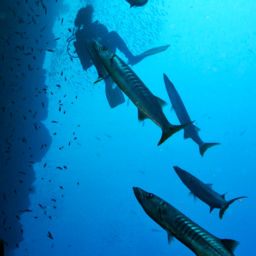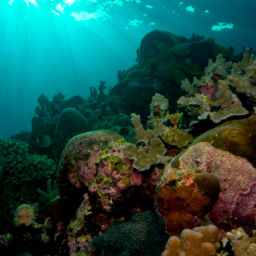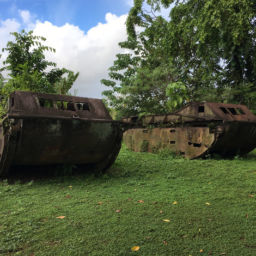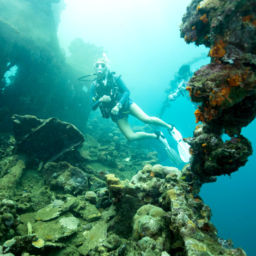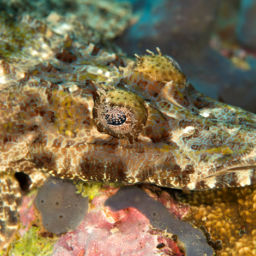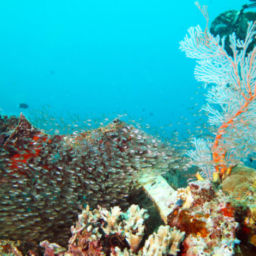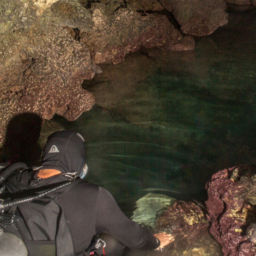Cross the famous watery graveyard of Iron Bottom Sound from Honiara, capital of the Solomon Islands, and you’ll find a hidden gem for lovers of wrecks and reefs: Tulagi.
Thanks to the Battle of Guadalcanal, one of the largest battles in WWII’s Pacific Arena, Tulagi in the Solomon Islands features an abundance of ship and plane wrecks. But with wonderful coral reefs and even muck diving, Tulagi really has something for everyone.
Located only one-hour boat ride from Honiara, Tulagi is one of the easiest dive destinations to reach in the Solomon Islands. This small island, part of the Nggela (Florida) Islands, was once the capital of the British Solomon Islands, chosen for its sheltered natural harbor. Today the island is a sleepy and tranquil getaway.
Wrecks of Tulagi
The area’s premier wreck is the USS Kanawha, a 475-foot (145 m) fuel tanker that Japanese dive bombers sank on April 7, 1943. Now resting at depth of 197 feet (60 m) this wreck is primarily accessible to tech divers. But you needn’t dive this deep, as you can see most of the ship’s features, including its guns, without exceeding 154 feet (47 m). Also sunk on the same day was the HMNZS Moa, a 168-foot (51 m) New Zealand minesweeper. This ship is in 130 feet (40 m), so a little shallower, but it sometimes suffers from poor visibility.
Also in the Tulagi area are several Wildcat fighter planes sitting between 115 to 130 feet (35 to 40 m). Much more accessible, however, are a fleet of seaplanes in depths of 65 to 115 feet (20 to 35 m). On a short stay you’ll probably explore an American Catalina and three Japanese Kawanishi (Mavis) seaplanes, all fascinating and home to a wonderful range of marine life.
One of the most interesting dive sites near Tulagi is a site called Base 1, which runs to around 85 feet (26 m). During the war, this site was a patrol-boat base for ship repairs. It is now an underwater junkyard with litter from the war, including artillery shells, steel barrels, coils of wire, plane wings and other scrap. At this site you’ll also find an American landing craft and the bow section of the heavy cruiser USS Minneapolis, which was cut off after being badly damaged. Many recent ships have also been dumped at this site as well.
Reefs of Tulagi
Tulagi also has some great reef diving for those not into shipwrecks. The area’s signature reef dive is a pinnacle rising from 197 feet (60 m) called Twin Tunnels Reef. This large pinnacle peaks at 39 feet (12 m) and its top is covered in beautiful hard corals. But its most colorful corals, including gorgonians, whip corals, soft corals and black coral trees, decorate its steep walls. The main features of the reef are two L-shape caves (or tunnels) that open on the top of the reef and exit on the wall at 108 feet (33 m). Home to a variety of reef fish, this reef is also a good place to see pelagic fish and reef sharks.
There are a number of other nice reefs close to Tulagi, and a half hour run up the coast will bring you to the wonderful wall at Tanavula Point. This stunning wall is colored by sponges, soft corals and gorgonians. On a gentle drift, you’ll encounter schools of fusiliers, reef sharks, bumphead parrotfish and trevally.
When to go
You can dive Tulagi at any time of the year, and the water temperature is usually between 82 to 86 F (28 to 30 C). Expect 65 to 100 feet (20 to 30 m) of visibility on the reefs, and 33 to 65 feet (10 to 20 m) visibility on the wrecks, which are mostly in the harbor area.
The wide variety of dive sites in Tulagi make it a sure a crowd pleaser — definitely a destination to add to your dive bucket list.











